Influence of Single- and Multi-Wall Carbon Nanotubes on Magnetohydrodynamic Stagnation Point Nanofluid Flow over Variable Thicker Surface with Concave and Convex Effects
Abstract
1. Introduction
2. Mathematical Formulation
3. Mathematical Analysis
3.1. OHAM (BVPh 2.0)
3.2. Optimal Convergence Analysis
4. Results and Discussion
5. Conclusions
- MWCNTs causes enhancement in velocity field as compared with SWCNTs when there is an increment in the nanoparticle volume fraction .
- Higher values given to the magnetic number reduce the flow velocity and are dominant for MWCNTs as compared with SWCNTs.
- Temperature profile rises with an increment in radiation estimator for both SWCNT and MWCNT.
- Augmented values of Eckert number enhance the thermal distribution, but lesser for SWCNT as compared with MWCNT.
- Friction coefficient rises for increments in , and for both type of nanotubes.
- Heat transfer rate lessens for increments in and for both SWCNT and MWCNT.
Author Contributions
Funding
Acknowledgments
Conflicts of Interest
Nomenclature
| Name/Title | Description | Unit |
| Cartesian (horizontal and vertical) coordinates | ||
| Velocity (horizontal and vertical) components | ||
| Kinematic viscosity of the nanofluid | ||
| Dynamic viscosity of the nanofluid | ||
| Magnetic field strength | ||
| Density of the base fluid | ||
| Density of the nanofluid | ||
| Thermal conductivity | ||
| Thermal diffiusivity | ||
| Temperature distributions | ||
| Stretching velocity | ||
| Concentration distributions | ||
| Brownian diffusion | ||
| Thermophoresis | ||
| Nusselt number | ||
| Sherwood number | ||
| Drag force coefficient | ||
| Brownian diffusion parameter | ||
| Thermophoresis parameter | ||
| Integer | ||
| Single-walled carbon nanotubes | ||
| Multi-walled carbon nanotubes | ||
| Carbon nanotubes | ||
| Magnetohydrodynamic |
References
- Choi, S. Enhancing Thermal Conductivity of Fluids with Nanoparticles; ASME Publications-Fed: San Francisco, CA, USA, 1995; pp. 99–106. [Google Scholar]
- Buongiorno, J. Convective transport in nanofluids. J. Heat Transf. 2006, 128, 240–250. [Google Scholar] [CrossRef]
- Buongiorno, J.; Venerus, D.C.; Prabhat, N.; McKrell, T.; Townsend, J.; Christianson, R.; Tolmachev, Y.V.; Keblinski, P.; Hu, L.W.; Alvarado, J.L.; et al. A benchmark study on the thermal conductivity of nanofluids. J. Appl. Phys. 2009, 106, 094312. [Google Scholar] [CrossRef]
- Rasool, G.; Zhang, T.; Shafiq, A. Second grade nanofluidic flow past a convectively heated vertical Riga plate. Phys. Scr. 2019, 94, 125212. [Google Scholar] [CrossRef]
- Rasool, G.; Zhang, T. Characteristics of chemical reaction and convective boundary conditions in Powell-Eyring nanofluid flow along a radiative Riga plate. Heliyon 2019, 5, e01479. [Google Scholar] [CrossRef] [PubMed]
- Rasool, G.; Shafiq, A.; Khalique, C.M.; Zhang, T. Magnetohydrodynamic Darcy Forchheimer nanofluid flow over nonlinear stretching sheet. Phys. Scr. 2019, 94, 105221. [Google Scholar] [CrossRef]
- Rasool, G.; Zhang, T.; Shafiq, A.; Durur, H. Influence of chemical reaction on Marangoni convective flow of nanoliquid in the presence of Lorentz forces and thermal radiation: A numerical investigation. J. Adv. Nanotechnol. 2019, 1, 32–49. [Google Scholar] [CrossRef]
- Rasool, G.; Zhang, T.; Shafiq, A. Marangoni effect in second grade forced convective flow of water based nanofluid. J. Adv. Nanotechnol. 2019, 1, 50–61. [Google Scholar] [CrossRef]
- Lund, L.A.; Omar, Z.; Khan, I.; Dero, S. Multiple solutions of and nanofluids flow over nonlinear shrinking surface. J. Cent. South Univ. 2019, 26, 1283–1293. [Google Scholar] [CrossRef]
- Lund, L.A.; Omar, Z.; Khan, I.; Raza, J.; Bakouri, M.; Tlili, I. Stability Analysis of Darcy-Forchheimer Flow of Casson Type Nanofluid Over an Exponential Sheet: Investigation of Critical Points. Symmetry 2019, 11, 412. [Google Scholar] [CrossRef]
- Rasool, G.; Zhang, T.; Chamkha, A.J.; Shafiq, A.; Tlili, I.; Shahzadi, G. Entropy Generation and Consequences of Binary Chemical Reaction on MHD Darcy–Forchheimer Williamson Nanofluid Flow Over Non-Linearly Stretching Surface. Entropy 2020, 22, 18. [Google Scholar] [CrossRef]
- Lund, L.A.; Omar, Z.; Khan, I. Steady incompressible magnetohydrodynamics Casson boundary layer flow past a permeable vertical and exponentially shrinking sheet: A stability analysis. Heat Transf. Asian Res. 2019. [Google Scholar] [CrossRef]
- Rasool, G.; Zhang, T. Darcy-Forchheimer nanofluidic flow manifested with Cattaneo-Christov theory of heat and mass flux over non-linearly stretching surface. PLoS ONE 2019, 14, e0221302. [Google Scholar] [CrossRef] [PubMed]
- Shafiq, A.; Khan, I.; Rasool, G.; Seikh, A.H.; Sherif, E.S.M. Significance of Double Stratification in Stagnation Point Flow of Third-Grade Fluid towards a Radiative Stretching Cylinder. Mathematics 2019, 7, 1103. [Google Scholar] [CrossRef]
- Shafiq, A.; Zari, I.; Rasool, G.; Tlili, I.; Khan, T.S. On the MHD Casson Axisymmetric Marangoni Forced Convective Flow of Nanofluids. Mathematics 2019, 7, 87. [Google Scholar] [CrossRef]
- Rasool, G.; Shafiq, A.; Tlili, I. Marangoni convective nano-fluid flow over an electromagnetic actuator in the presence of first order chemical reaction. Heat Transf. Asian Res. 2019. [Google Scholar] [CrossRef]
- Rasool, G.; Shafiq, A.; Durur, H. Darcy-Forchheimer relation in Magnetohydrodynamic Jeffrey nanofluid flow over stretching surface. In Discrete and Continuous Dynamical Systems—Series S; American Institute of Mathematical Sciences: San Jose, CA, USA, 2019. [Google Scholar]
- Rasool, G.; Shafiq, A.; Khalique, C.M. Marangoni forced convective Casson type nanofluid flow in the presence of Lorentz force generated by Riga plate. In Discrete and Continuous Dynamical Systems—Series S; American Institute of Mathematical Sciences: San Jose, CA, USA, 2019. [Google Scholar]
- Kim, Y.J.; Shin, T.S.; Choi, H.D.; Kwon, J.H.; Chung, Y.C.; Yoon, H.G. Electrical conductivity of chemically modified multiwalled carbon nanotube/epoxy composites. Carbon 2005, 43, 23–30. [Google Scholar] [CrossRef]
- Xue, Q. Model for thermal conductivity of carbon nanotube based composites. Phys. B Condens. Matter 2005, 368, 302–307. [Google Scholar] [CrossRef]
- Liu, M.S.; Lin, M.C.C.; I-Te, H.; Wang, C.C. Enhancement of thermal conductivity with carbon nanotube for nanofluids. Int. Commun. Heat Mass Transf. 2005, 32, 1202–1210. [Google Scholar] [CrossRef]
- Ding, Y.; Alias, H.; Wen, D.; Williams, R.A. Heat transfer of aqueous suspensions of carbon nanotubes (CNT nanofluids). Int. J. Heat Mass Transf. 2006, 49, 240–250. [Google Scholar] [CrossRef]
- Ma, X.; Su, F.; Chen, J.; Bai, T.; Han, Z. Enhancement of bubble absorption process using a CNTs-ammonia binary nanofluid. Int. Commun. Heat Mass. Transf. 2009, 36, 657–660. [Google Scholar] [CrossRef]
- Choi, J.; Zhang, Y. Properties and Applications of Single-, Double- and Multi-Walled Carbon Nanotubes. In Aldrich Materials Science; Sigma-Aldrich Co. LLC: Steinheim, Germany, 1995. [Google Scholar]
- Sumio, I. Helical microtubules of graphitic carbon. Nature 1991, 354, 354–561. [Google Scholar]
- Choi, S.U.S.; Zhang, Z.G.; Yu, W.; Lockwood, F.E.; Grulke, E.A. Anomalous thermal conductivity enhancement in nanotube suspensions. Appl. Phys. Lett. 2001, 79, 2252. [Google Scholar] [CrossRef]
- Hone, J. Carbon nanotubes: Thermal properties. In Dekker Encyclopedia of Nanoscience and Nanotechnology; CRC Press: New York, NY, USA, 2004; pp. 603–610. [Google Scholar]
- Kamali, R.; Binesh, A. Numerical investigation of heat transfer enhancement using carbon nanotube-based non-Newtonian nanofluids. Int. Commun. Heat Mass Transf. 2010, 37, 1153–1157. [Google Scholar] [CrossRef]
- Prajapati, V.; Sharma, P.K.; Banik, A. Carbon nanotubes and its applications. Int. J. Pharm. Sci. Res. 2011, 2, 1099–1107. [Google Scholar]
- Kumaresan, V.; Velraj, R.; Das, S.K. Convective heat transfer characteristics of secondary refrigerant based CNT nanofluids in a tubular heat exchanger. Int. J. Refrig. 2012, 35, 2287–2296. [Google Scholar] [CrossRef]
- Wang, J.; Zhu, J.; Zhang, X.; Chen, Y. Heat transfer and pressure drop of nanofluids containing carbon nanotubes in laminar flows. Exp. Therm. Fluid Sci. 2013, 44, 716–721. [Google Scholar] [CrossRef]
- Khan, W.A.; Khan, Z.H.; Rahi, M. Fluid flow and heat transfer of carbon nanotubes along a flat plate with Navier slip boundary. Appl. Nanosci. 2013. [Google Scholar] [CrossRef]
- Noreen, S.A.; Nadeem, S.; Khan, Z.H. Thermal and velocity slip effects on the MHD peristaltic flow with carbon nanotubes in an asymmetric channel: Application of radiation therapy. Appl. Nanosci. 2013. [Google Scholar] [CrossRef]
- Noreen, S.A.; Khan, Z.H. Heat transfer study of an individual multiwalled carbon nanotube due to metachronal beating of cilia. Int. Commun. Heat Mass Transf. 2014, 59, 114–119. [Google Scholar]
- Ebaid, A.; al Sharif, M. Application of Laplace transform for the exact effect of a magnetic field on heat transfer of carbon-nanotubes suspended nanofluids. Zeitschrift für Naturforschung A 2015, 70, 471–475. [Google Scholar] [CrossRef]
- Haq, R.U.; Nadeem, S.; Khan, Z.H.; Noor, N.F.M. Convective heat transfer in MHD slip flow over a stretching surface in the presence of carbon nanotubes. Phys. B Condens. Matter 2015, 457, 40–47. [Google Scholar] [CrossRef]
- Kandasamy, R.; Mohamad, R.; Ismoen, M. Impact of chemical reaction on Cu, Al2O3, and SWCNTs-nanofluid flow under slip conditions. Eng. Sci. Technol. Int. J. 2016, 19, 700–709. [Google Scholar] [CrossRef][Green Version]
- Kandasamy, R.; Muhaimin, I.; Mohammad, R. Single walled carbon nanotubes on MHD unsteady flow over a porous wedge with thermal radiation with variable stream conditions. Alex. Eng. J. 2016, 55, 275–285. [Google Scholar] [CrossRef]
- Mohammad, R.; Kandasamy, R. Nanoparticle shapes on electric and magnetic force in water, ethylene glycol and engine oil based Cu, Al and SWCNTs. J. Mol. Liq. 2017, 237, 54–64. [Google Scholar] [CrossRef]
- Zhang, P.; Hong, W.; Wu, J.F.; Liu, G.Z.; Xiao, J.; Chen, Z.B.; Cheng, H.B. Effects of surface modification on the suspension stability and thermal conductivity of carbon nanotubes nanofluids. Energy Procedia 2015, 69, 699–705. [Google Scholar] [CrossRef][Green Version]
- Aman, S.; Khan, I.; Ismail, Z.; Salleh, M.Z.; Al-Mdall, Q.M. Heat transfer enhancement in free convection flow of CNTs Maxwell nanofluids with four different types of molecular liquid. Sci. Rep. 2017, 7, 2445. [Google Scholar] [CrossRef]
- Soleimani, H.; Baig, M.K.; Yahya, N.; Khodapanah, L.K.; Sabet, M.; Demiral, B.M.R.; Burda, M. Impact of carbon nanotubes based nanofluid on oil recovery efficiency using core flooding. Results Phys. 2018, 9, 39–48. [Google Scholar] [CrossRef]
- Taheriang, H.; Alvarado, J.L.; Languri, E.M. Enhanced thermophysical properties of multiwalled carbon nanotubes based nanofluids. Part 1: Critical review. Renew. Sustain. Energy Rev. 2018, 82, 4326–4336. [Google Scholar] [CrossRef]
- Wang, R.; Xie, L.; Hameed, S.; Wang, C.; Ying, Y. Mechanisms and applications of carbon nanotubes in terahertz devices: A review. Carbon 2018, 132, 42–58. [Google Scholar] [CrossRef]
- Pop, S.; Grosan, T.; Pop, I. Radiation effects on the flow near the stagnation point of a stretching sheet. Technol. Mech. 2004, 25, 100–106. [Google Scholar]
- Sharma, P.; Singh, G. Effects of variable thermal conductivity and heat source/sink on MHD flow near a stagnation point on a linearly stretching sheet. J. Appl. Fluid Mech. 2009, 2, 13–21. [Google Scholar]
- Haq, R.U.; Khan, Z.H.; Khan, W.A. Thermophysical effects of carbon nanotubes on MHD flow over a stretching surface. Phys. E Low-Dimens. Syst. Nanostruct. 2014, 63, 215–222. [Google Scholar] [CrossRef]
- Haq, R.U.; Khan, Z.H.; Khan, W.A.; Shah, I.A. Viscous Dissipation Effects in Water Driven Carbon Nanotubes along a Stream Wise and Cross Flow Direction. Int. J. Chem. React. Eng. 2017, 15. [Google Scholar] [CrossRef]
- Hussain, S.T.; Haq, R.U.; Khan, Z.H.; Nadeem, S. Water drivenflow of carbon nanotubes in a rotating channel. J. Mol. Liq. 2016, 214, 136–144. [Google Scholar] [CrossRef]
- Haq, R.U.; Rashid, I.; Khan, Z.H. Effects of aligned magneticfield and CNTs in two different base fluids over a moving slip surface. J. Mol. Liq. 2017, 243, 682–688. [Google Scholar] [CrossRef]
- Haq, R.U.; Kazmi, S.N.; Mekkaoui, T. Thermal management of water based SWCNTs enclosed in a partiallyheated trapezoidal cavity via FEM. Int. J. Heat Mass Transf. 2017, 112, 972–982. [Google Scholar] [CrossRef]
- Haq, R.U.; Soomro, F.A.; Hammouch, Z.; Rehman, S.U. Heat exchange within the partially heated C-shape cavity filled with thewater based SWCNTs. Int. J. Heat Mass Transf. 2018, 127, 506–514. [Google Scholar] [CrossRef]
- Karimipour, A.; Bagherzadeh, S.A.; Taghipour, A.; Abdollahi, A.; Safaei, M.R. A novel nonlinear regression model of SVR as a substitute for ANN to predict conductivity of MWCNT-CuO/water hybrid nanofluid based on empirical data. Phys. A Stat. Mech. Appl. 2019, 521, 89–97. [Google Scholar] [CrossRef]
- Karimipour, A.; D’Orazio, A.; Goodarzi, M. Develop the lattice Boltzmann method to simulate the slip velocity and temperature domain of buoyancy forces of FMWCNT nanoparticles in water through a micro flow imposed to the specified heat flux. Phys. A Stat. Mech. Appl. 2018, 509, 729–745. [Google Scholar] [CrossRef]
- Safaei, M.R.; Togun, H.; Vafai, K.; Kazi, S.N.; Badarudin, A. Investigation of Heat Transfer Enhancement in a Forward-Facing Contracting Channel Using FMWCNT Nanofluids. Numer. Heat Transf. Part A Appl. 2014, 66, 1321–1340. [Google Scholar] [CrossRef]
- Jalali, E.; Akbari, O.A.; Sarafraz, M.M.; Abbas, T.; Safaei, M.R. Heat Transfer of Oil/MWCNT Nanofluid Jet Injection Inside a Rectangular Microchannel. Symmetry 2019, 11, 757. [Google Scholar] [CrossRef]
- Aghaei, A.; Sheikhzadeh, G.A.; Goodarzi, M.; Hasani, H.; Damirchi, H.; Afrand, M. Effect of horizontal and vertical elliptic baffles inside an enclosure on the mixed convection of a MWCNTs-water nanofluid and its entropy generation. Eur. Phys. J. Plus 2018, 133, 486. [Google Scholar] [CrossRef]
- Esfe, M.H.; Emami, R.; Amiri, M.K. Experimental investigation of effective parameters on MWCNT–TiO2/SAE50 hybrid nanofluid viscosity. J. Therm. Anal. Calorim. 2019. [Google Scholar] [CrossRef]
- Bagherzadeh, S.A.; D’Orazio, A.; Karimipour, A.; Goodarzi, M.; Bach, Q.V. A novel sensitivity analysis model of EANN for F-MWCNTs–Fe3O4/EG nanofluid thermal conductivity: Outputs predicted analytically instead of numerically to more accuracy and less costs. Phys. A Stat. Mech. Appl. 2019, 521, 406–415. [Google Scholar] [CrossRef]
- Ghasemi, A.; Hassani, M.; Goodarzi, M.; Afrand, M.; Manafi, S. Appraising influence of COOH-MWCNTs on thermal conductivity of antifreeze using curve fitting and neural network. Phys. A Stat. Mech. Appl. 2019, 514, 36–45. [Google Scholar] [CrossRef]
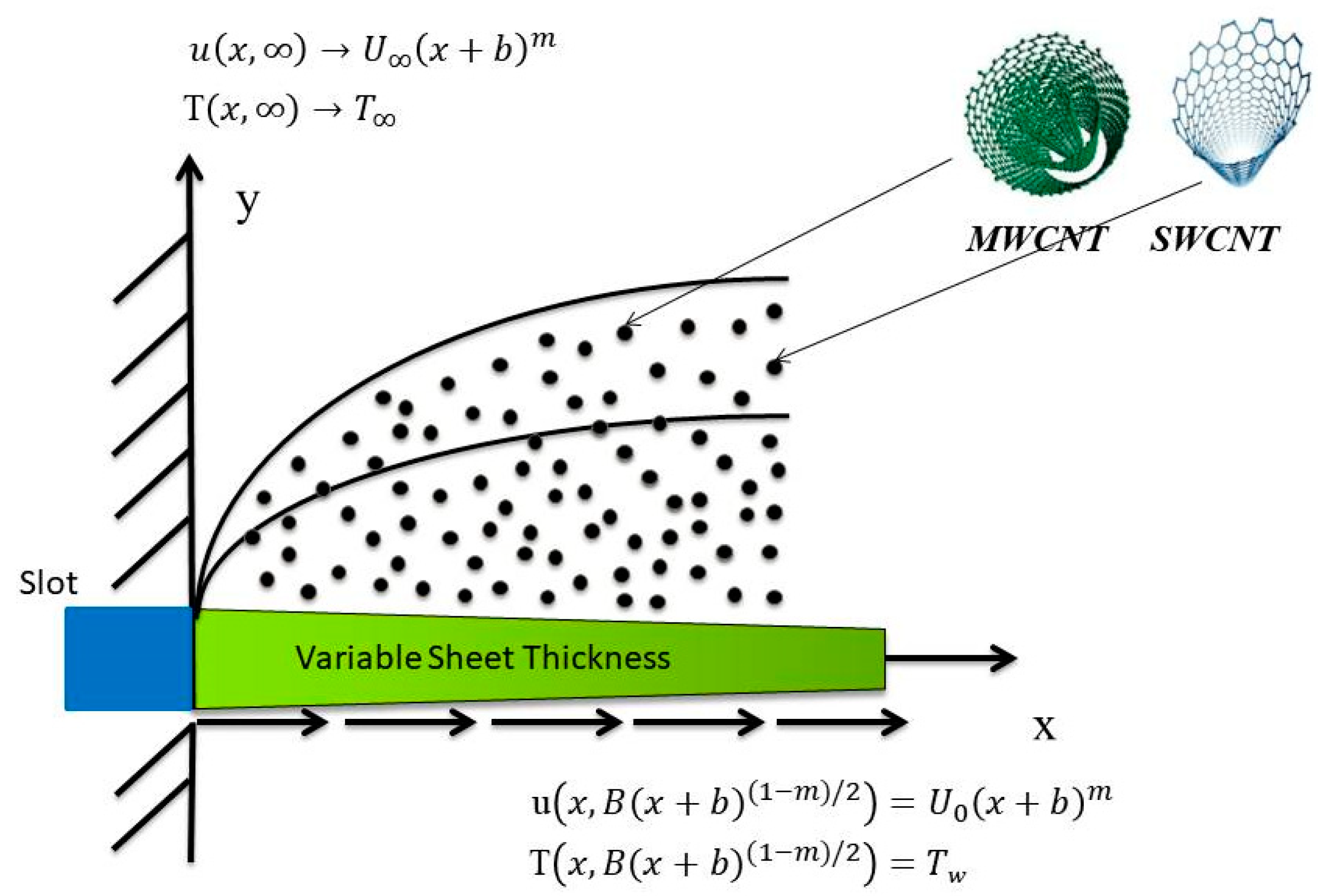
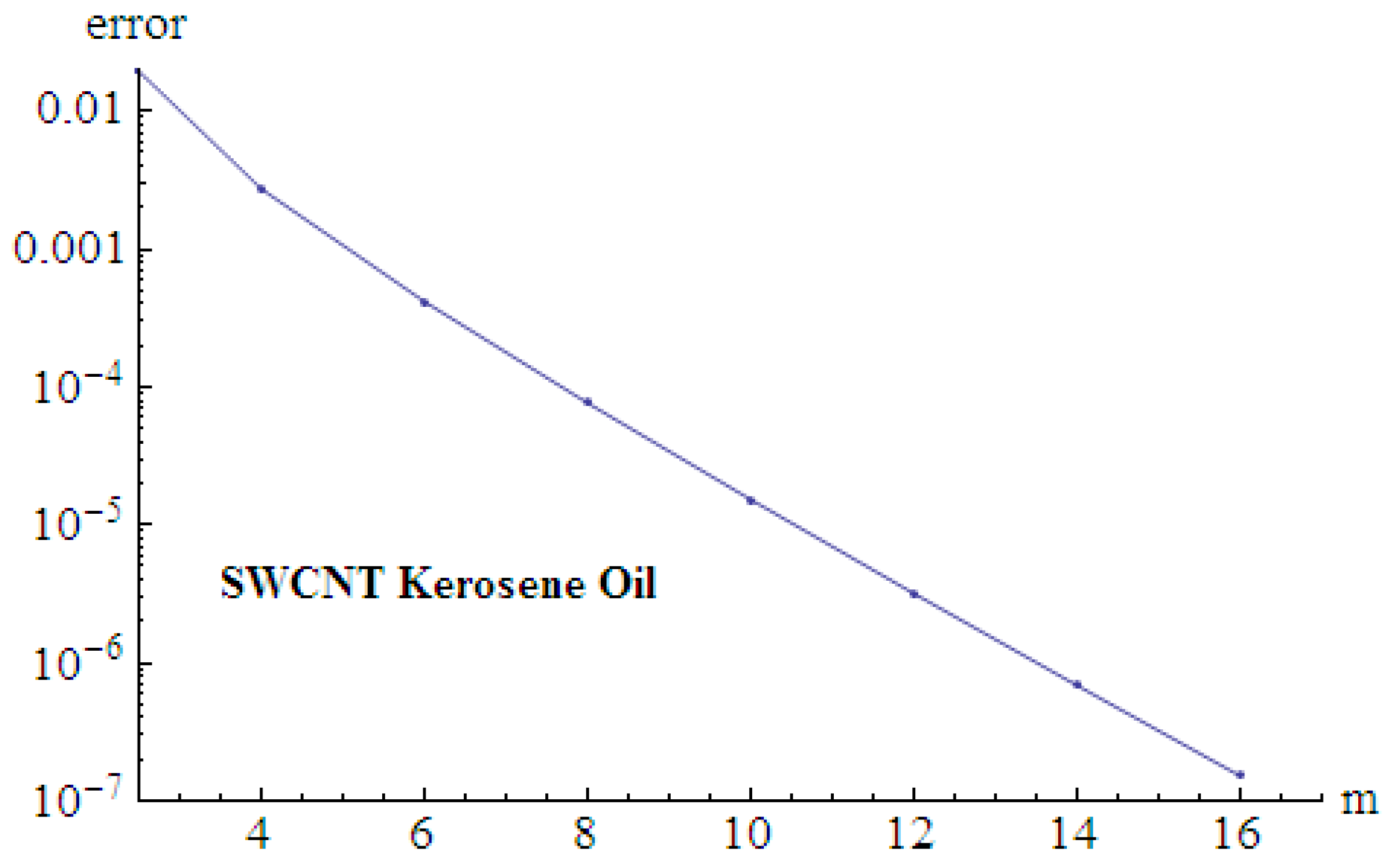
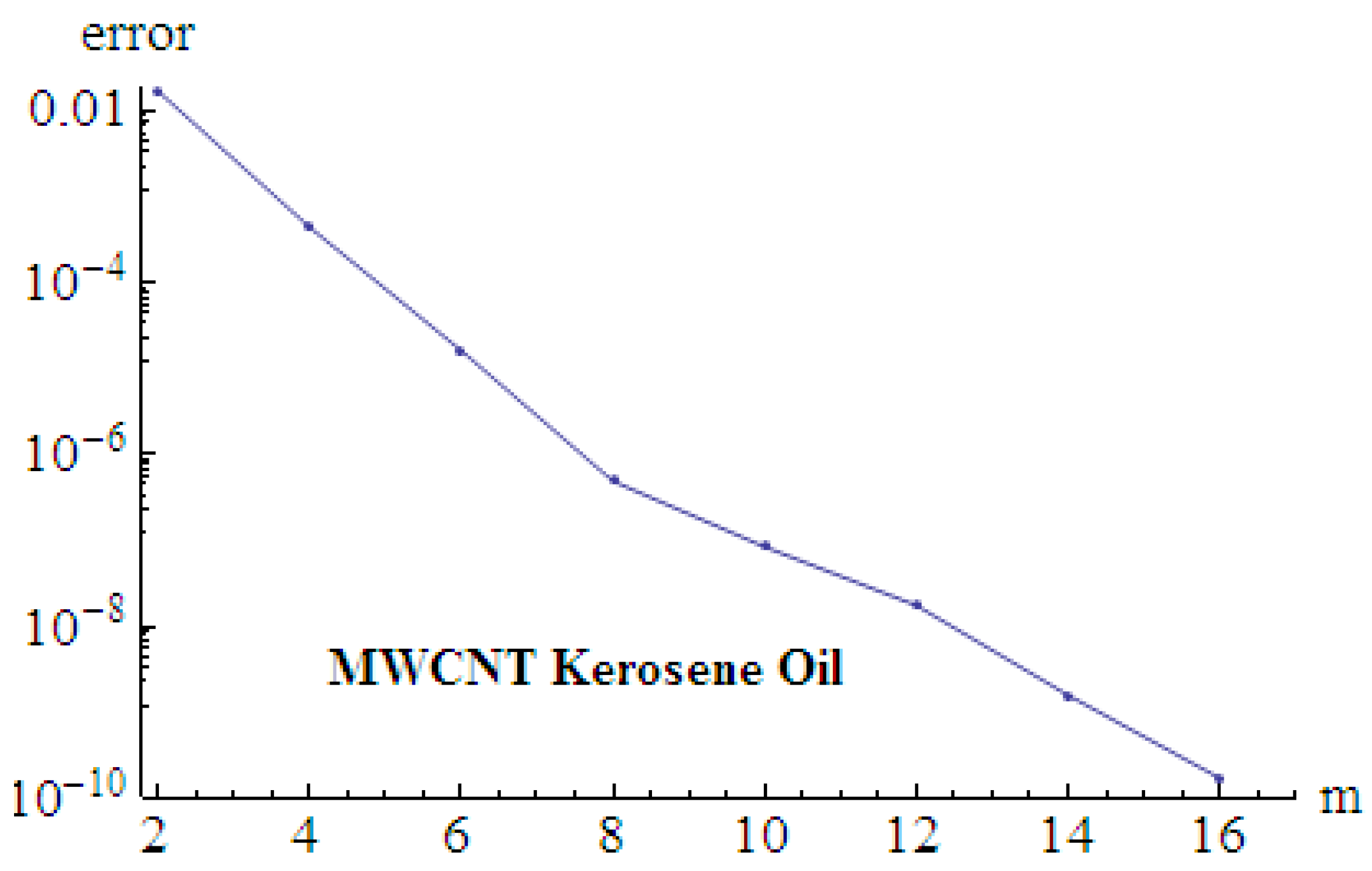
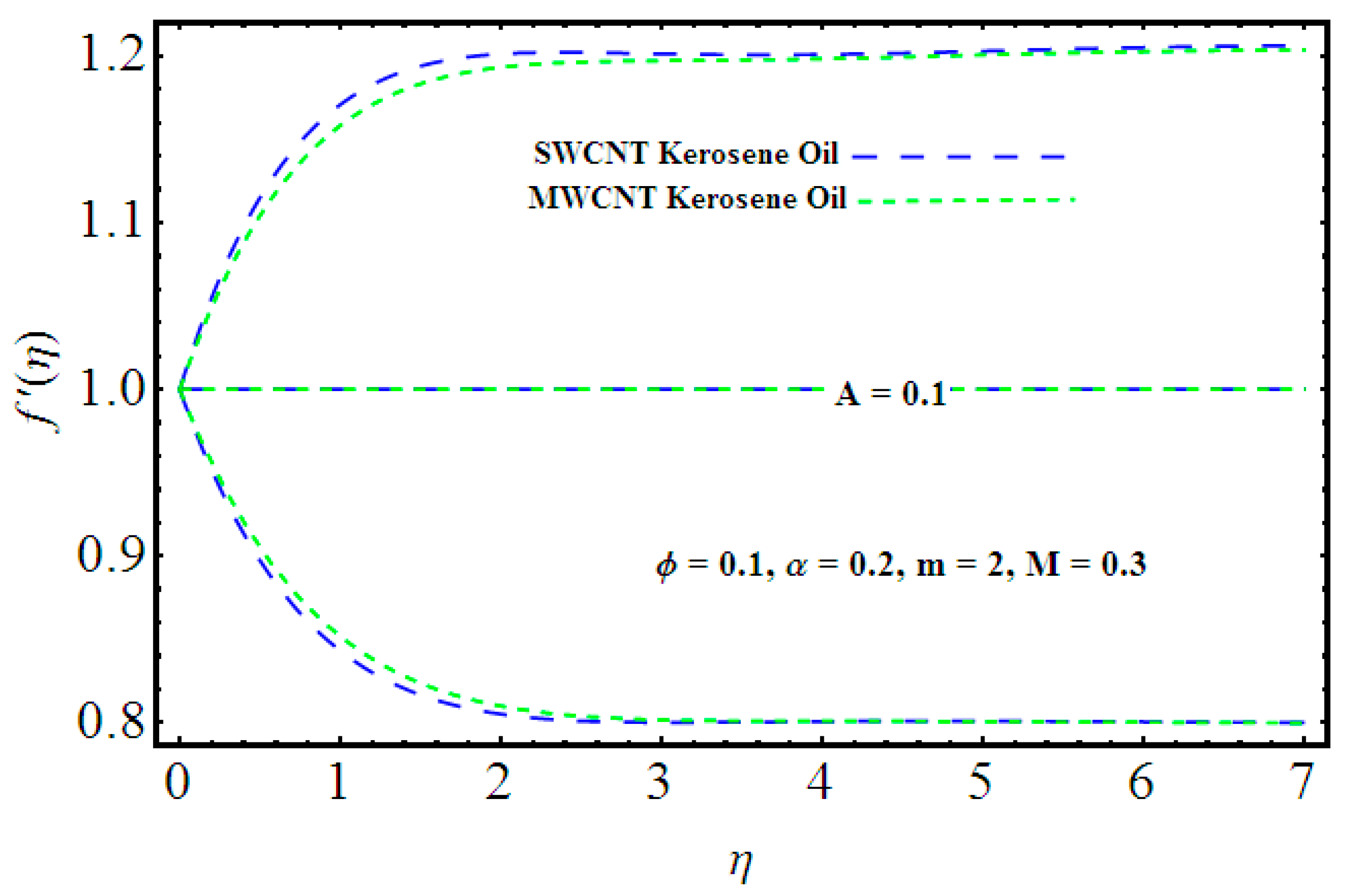
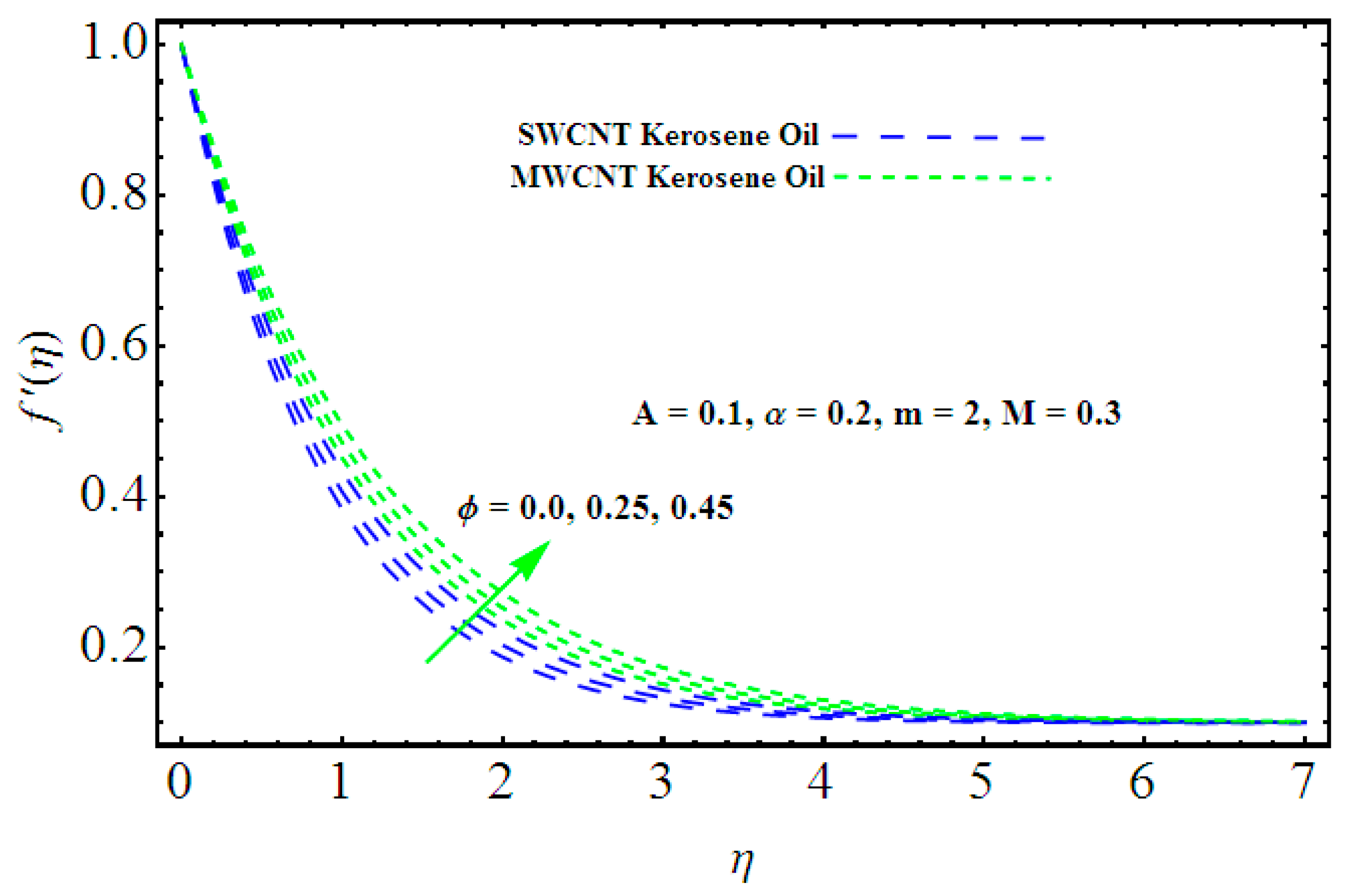
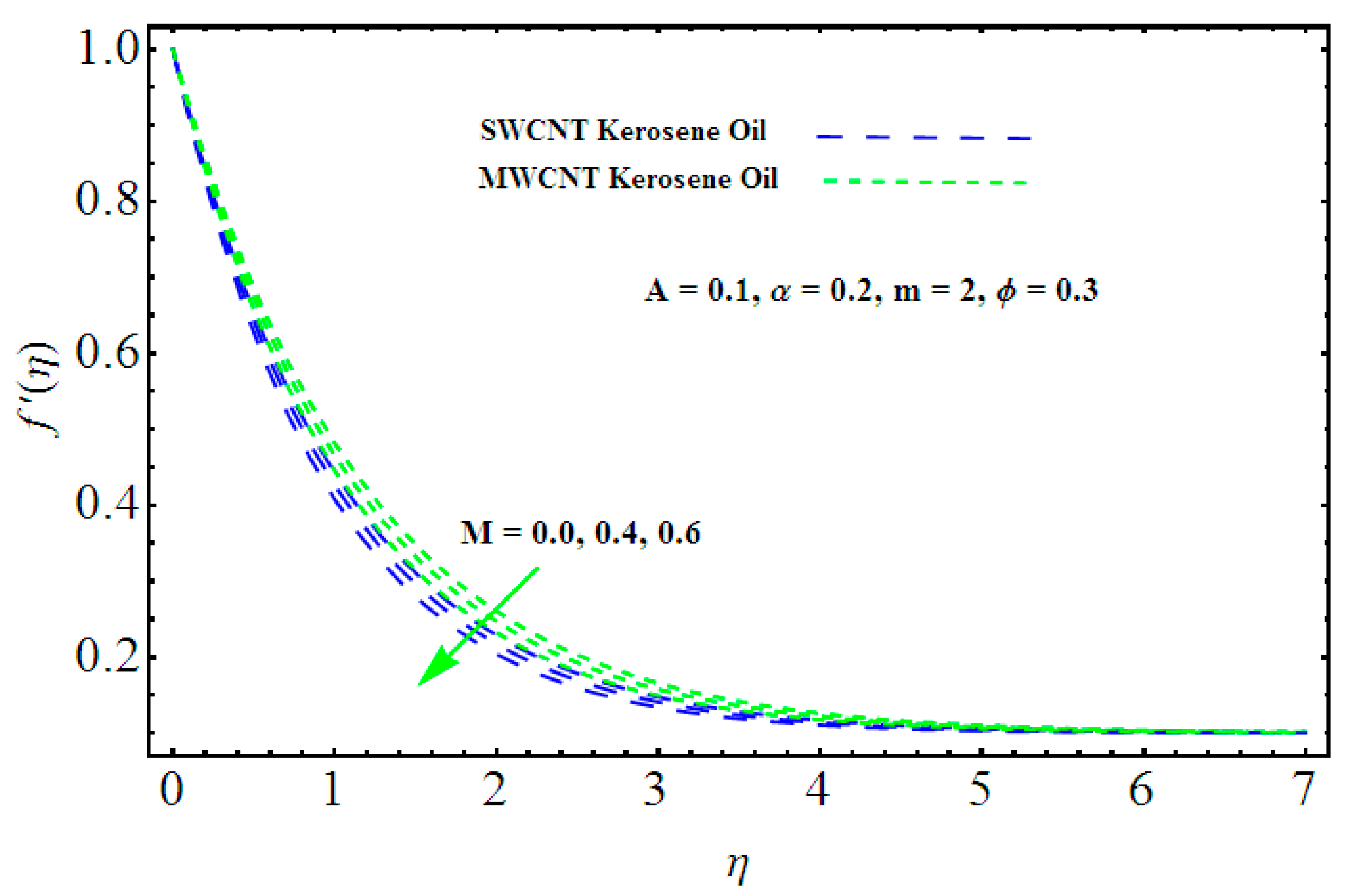
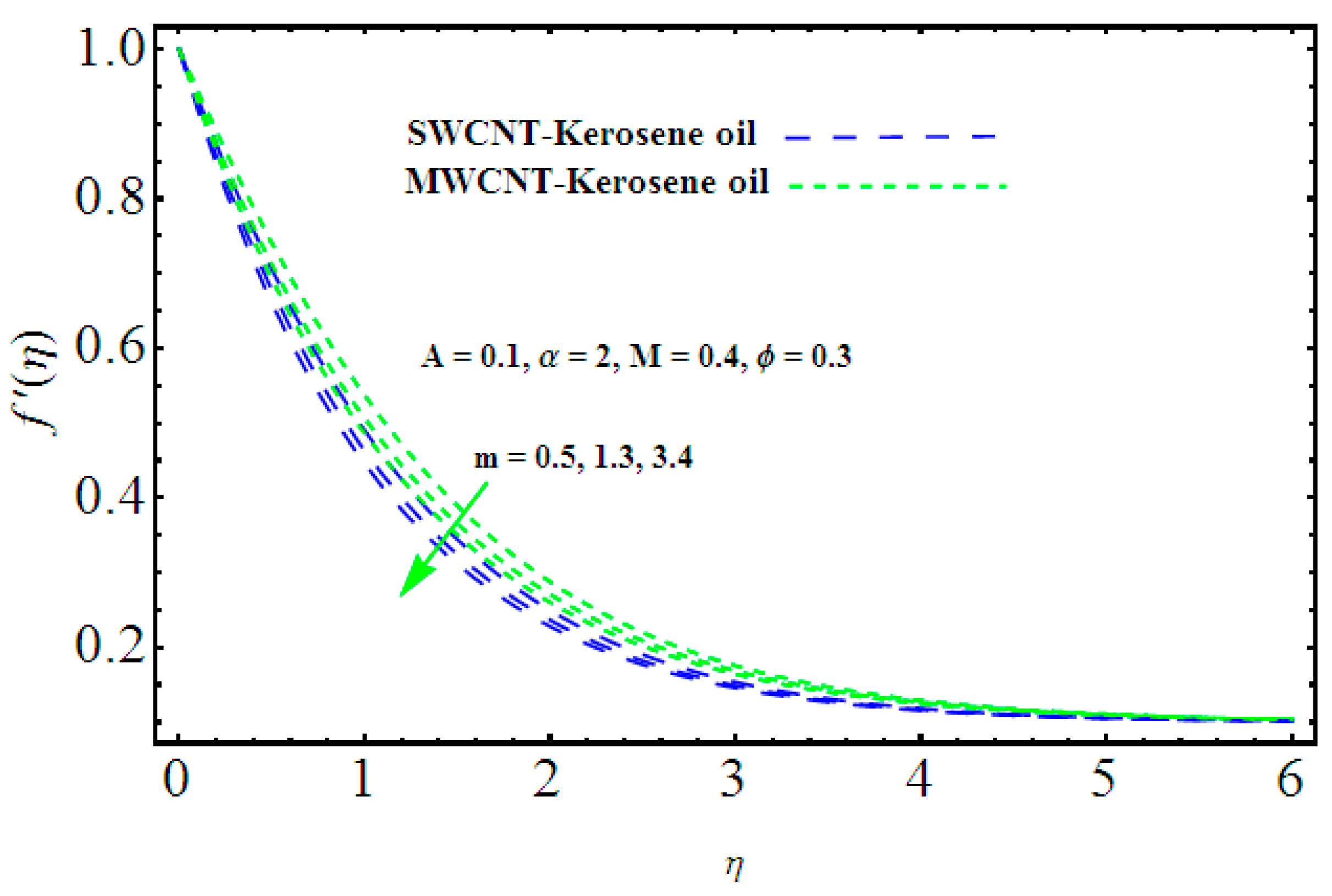
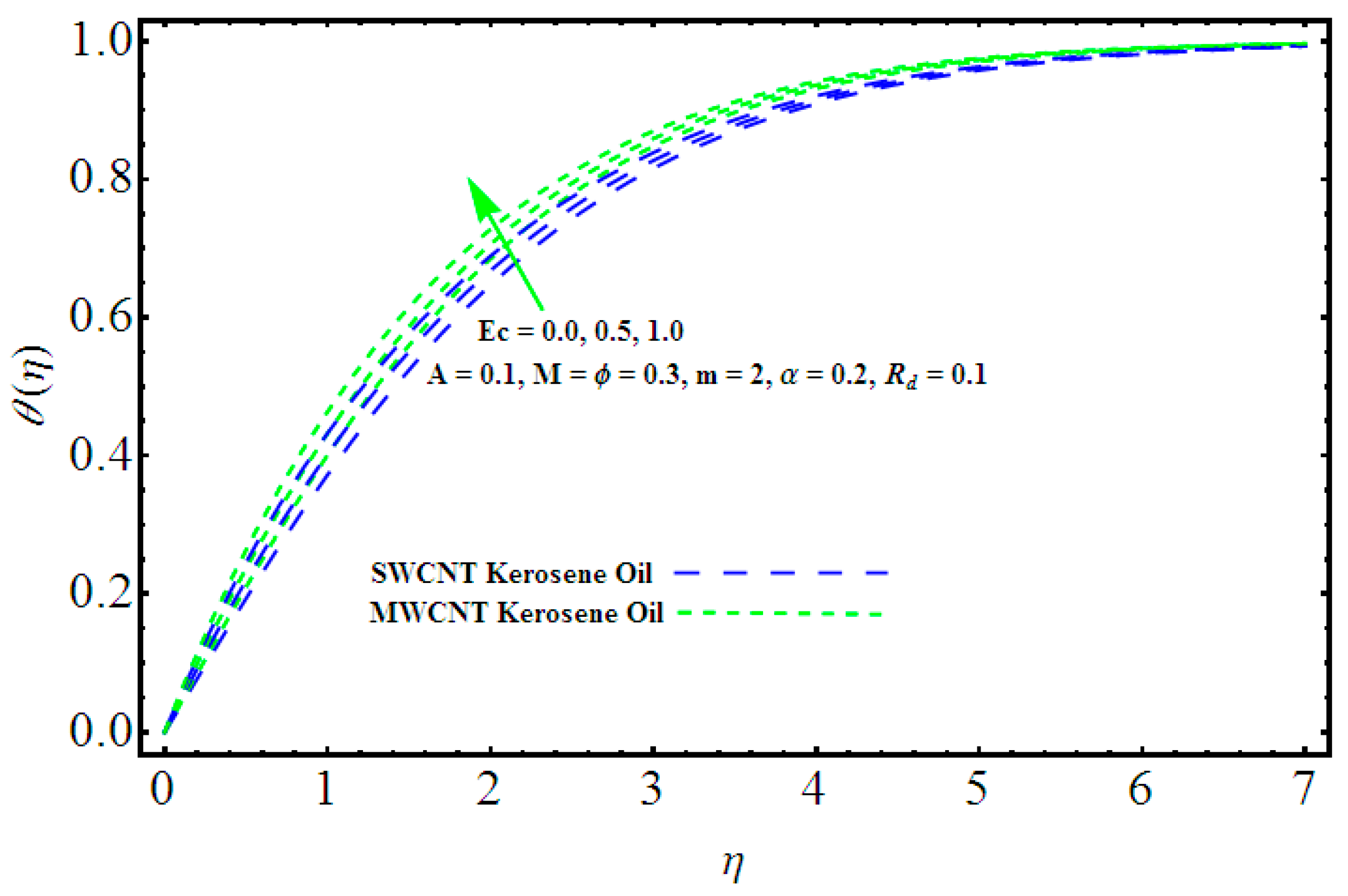
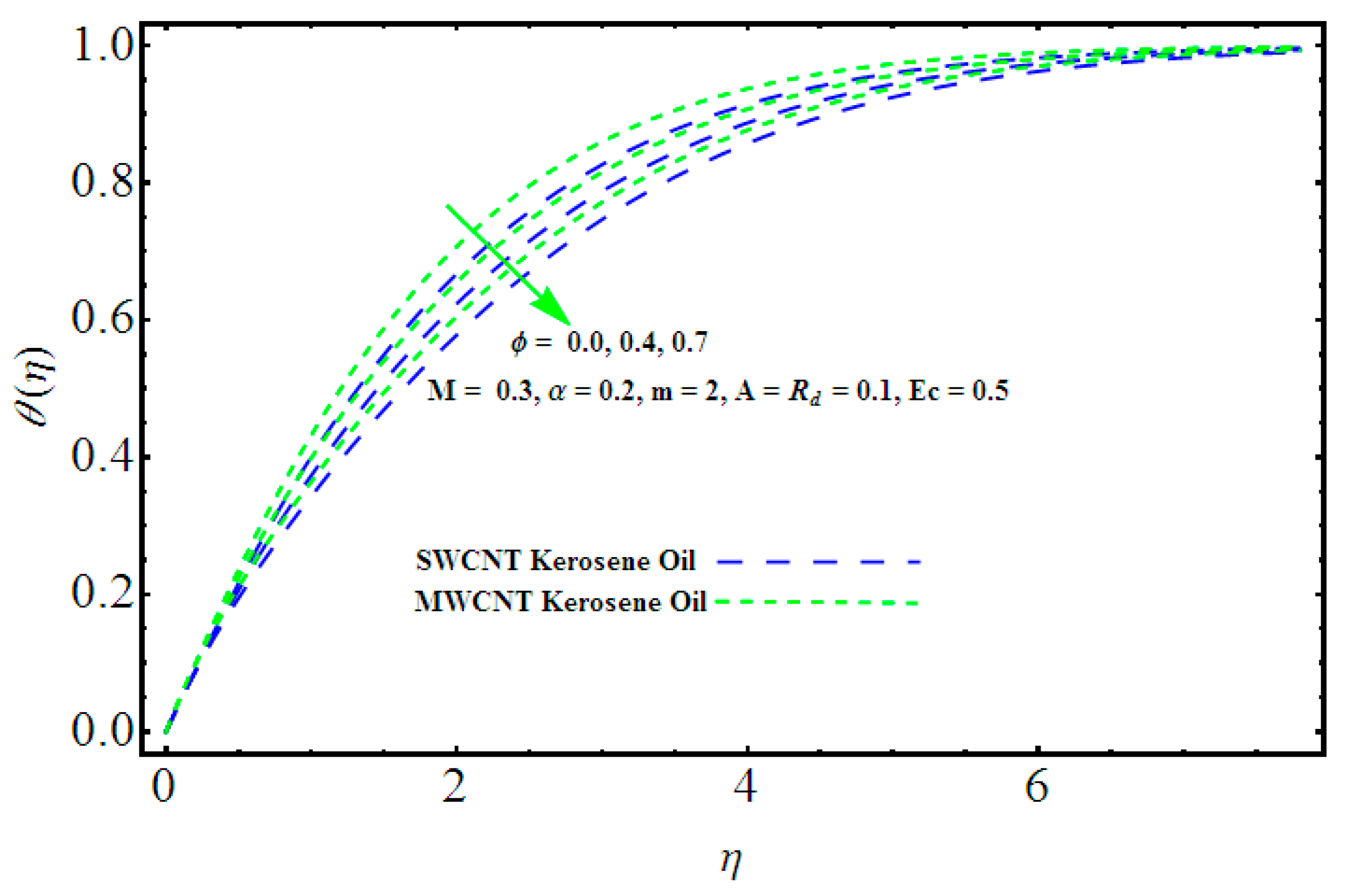
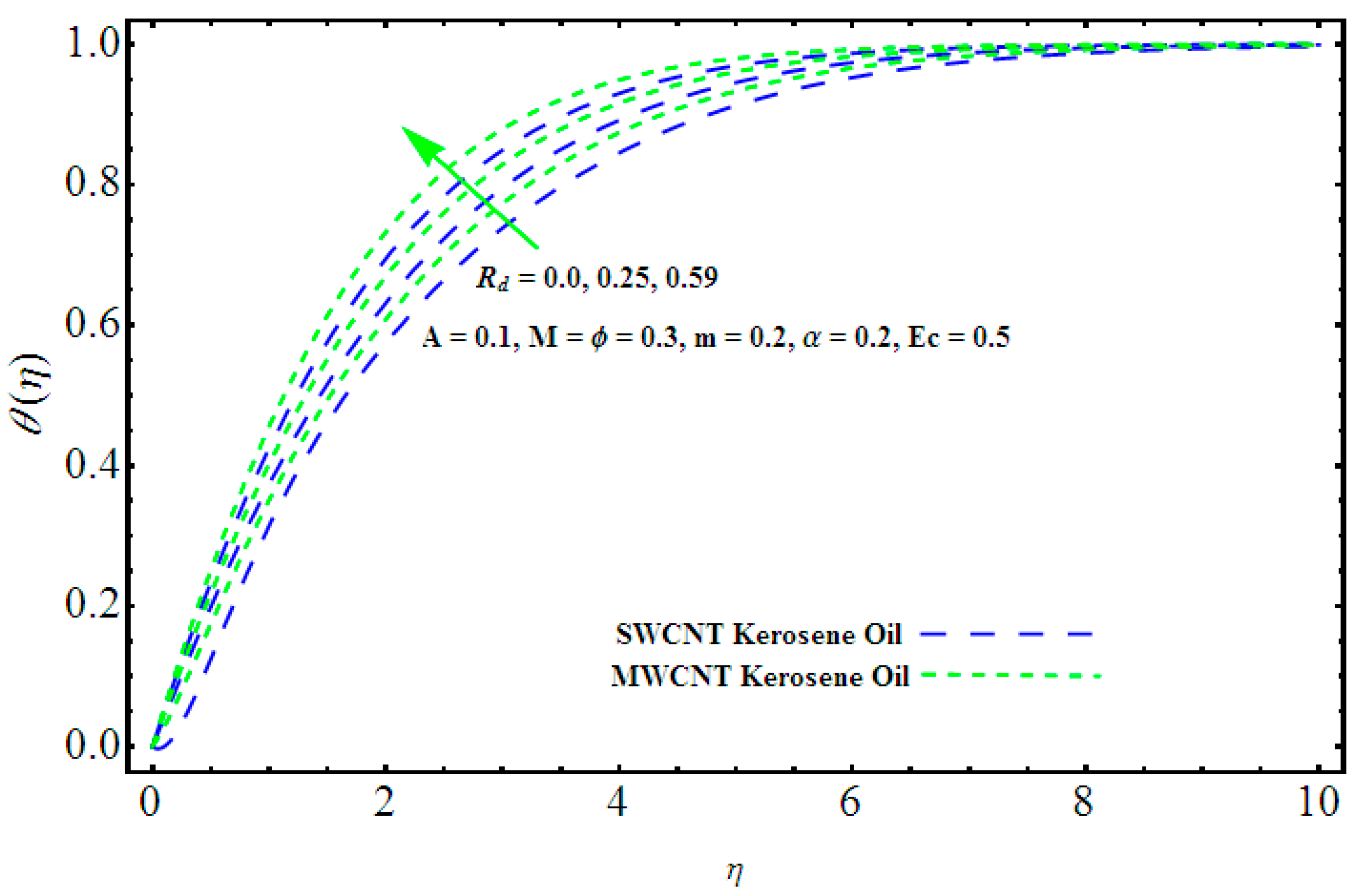
| Properties | Base Fluid | Particles | |
|---|---|---|---|
| Kerosene Oil | SWCNT | MWCNT | |
| 783 | 2600 | 1600 | |
| 2090 | 425 | 796 | |
| 0.145 | 6600 | 3000 | |
| SWCNT | MWCNT | |||
|---|---|---|---|---|
| 12 | ||||
| SWCNT | MWCNT | |||||
|---|---|---|---|---|---|---|
| 0.0 | 0.1 | 0.3 | 0.3 | 2 | 2.55298 | 2.75297 |
| 0.2 | 2.69267 | 2.69167 | ||||
| 0.4 | 2.63276 | 2.63177 | ||||
| 0.2 | 0.0 | 0.3 | 0.3 | 2 | 2.78805 | 2.78805 |
| 0.1 | 2.69106 | 2.69106 | ||||
| 0.2 | 2.54457 | 2.54457 | ||||
| 0.2 | 0.1 | 0.0 | 0.3 | 2 | 3.65298 | 3.75297 |
| 0.2 | 3.69267 | 3.69167 | ||||
| 0.4 | 3.62276 | 3.62377 | ||||
| 0.2 | 0.1 | 0.3 | 0.0 | 2 | 2.61848 | 2.60848 |
| 0.2 | 2.65576 | 2.64576 | ||||
| 0.4 | 2.77469 | 2.75469 | ||||
| 0.2 | 0.1 | 0.3 | 0.3 | 0.0 | 3.51365 | 3.52365 |
| 0.2 | 3.55576 | 3.53476 | ||||
| 0.4 | 3.57869 | 3.57469 | ||||
| SWCNT | MWCNT | ||||||
|---|---|---|---|---|---|---|---|
| 0.0 | 0.1 | 0.3 | 0.3 | 0.1 | 0.5 | 5.84027 | 5.94427 |
| 0.2 | 5.64158 | 5.65078 | |||||
| 0.4 | 5.32405 | 5.36445 | |||||
| 0.2 | 0.0 | 0.3 | 0.3 | 0.1 | 0.5 | 5.72660 | 5.72560 |
| 0.1 | 5.78191 | 5.77091 | |||||
| 0.2 | 5.82148 | 5.81148 | |||||
| 0.2 | 0.1 | 0.0 | 0.3 | 0.1 | 0.5 | 3.45876 | 3.45876 |
| 0.2 | 3.55896 | 3.55896 | |||||
| 0.4 | 3.78451 | 3.78451 | |||||
| 0.2 | 0.1 | 0.3 | 0.0 | 0.1 | 0.5 | 5.65429 | 5.65469 |
| 0.2 | 5.64380 | 5.64280 | |||||
| 0.4 | 5.62461 | 5.61561 | |||||
| 0.2 | 0.1 | 0.3 | 0.3 | 0.0 | 0.5 | 6.25429 | 6.25129 |
| 0.2 | 7.34380 | 7.34281 | |||||
| 0.4 | 7.62461 | 7.63461 | |||||
| 0.2 | 0.1 | 0.3 | 0.3 | 0.1 | 0.0 | 4.15419 | 4.15229 |
| 0.2 | 4.34280 | 4.35282 | |||||
| 0.4 | 4.62263 | 4.62462 | |||||
© 2020 by the authors. Licensee MDPI, Basel, Switzerland. This article is an open access article distributed under the terms and conditions of the Creative Commons Attribution (CC BY) license (http://creativecommons.org/licenses/by/4.0/).
Share and Cite
Shafiq, A.; Khan, I.; Rasool, G.; Sherif, E.-S.M.; Sheikh, A.H. Influence of Single- and Multi-Wall Carbon Nanotubes on Magnetohydrodynamic Stagnation Point Nanofluid Flow over Variable Thicker Surface with Concave and Convex Effects. Mathematics 2020, 8, 104. https://doi.org/10.3390/math8010104
Shafiq A, Khan I, Rasool G, Sherif E-SM, Sheikh AH. Influence of Single- and Multi-Wall Carbon Nanotubes on Magnetohydrodynamic Stagnation Point Nanofluid Flow over Variable Thicker Surface with Concave and Convex Effects. Mathematics. 2020; 8(1):104. https://doi.org/10.3390/math8010104
Chicago/Turabian StyleShafiq, Anum, Ilyas Khan, Ghulam Rasool, El-Sayed M. Sherif, and Asiful H. Sheikh. 2020. "Influence of Single- and Multi-Wall Carbon Nanotubes on Magnetohydrodynamic Stagnation Point Nanofluid Flow over Variable Thicker Surface with Concave and Convex Effects" Mathematics 8, no. 1: 104. https://doi.org/10.3390/math8010104
APA StyleShafiq, A., Khan, I., Rasool, G., Sherif, E.-S. M., & Sheikh, A. H. (2020). Influence of Single- and Multi-Wall Carbon Nanotubes on Magnetohydrodynamic Stagnation Point Nanofluid Flow over Variable Thicker Surface with Concave and Convex Effects. Mathematics, 8(1), 104. https://doi.org/10.3390/math8010104








